Wolves



Welcome to Wolf411.webstarts.com! This is a non-profit website dedicated 100% to Wolf Education and Information.
ANATOMY:
BEHAVIOR:
HUNTING:
FACTS:
Wolves are amazing creatures not just because of their unique and endearing personalities and beautiful features, but because of the amazing physical structure that allows them to adapt to their specific environment. They are perfectly built for the challenges of their home - whether the frozen tundra of the Arctic, rugged mountains with deep forests, or in the arid southwest.
TEETH:
Extremely powerful jaws and razor sharp teeth are imperative on the hunt. Wolves have some of the most powerful jaw pressure of any canine at roughly 1,500 psi. This is compared to a German Shepherd averaging around 750 psi and a pit bull in the area of 900 psi.
Extremely powerful jaws and razor sharp teeth are imperative on the hunt. Wolves have some of the most powerful jaw pressure of any canine at roughly 1,500 psi. This is compared to a German Shepherd averaging around 750 psi and a pit bull in the area of 900 psi.

SIZE:
Wolves range in size from the Red wolf, which is about the size of a coyote, to the Arctic wolf which can measure over 30 inches at the shoulder!
Their body weight also varies greatly with smaller species of wolves weighing around 50lbs to the largest of species weighing over 150lbs. They, like many other mammals, follow Bergmann's rule which explains why wolves in warmer climates (like the Mexican Grey Wolf) are much smaller then their colder climate cousins.
Wolves range in size from the Red wolf, which is about the size of a coyote, to the Arctic wolf which can measure over 30 inches at the shoulder!
Their body weight also varies greatly with smaller species of wolves weighing around 50lbs to the largest of species weighing over 150lbs. They, like many other mammals, follow Bergmann's rule which explains why wolves in warmer climates (like the Mexican Grey Wolf) are much smaller then their colder climate cousins.
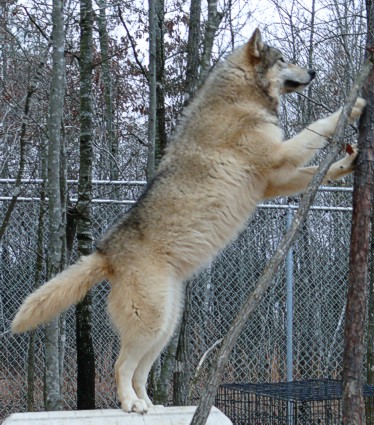
PAWS:
Wolves, like dogs, have four front claws on their toes and a fifth claw on the inside of their front legs called a "dew claw". While the paws of a Mexican Grey Wolf are much smaller because of their size, an Arctic Wolf can have paws that are as large or larger than a humans hand!
Wolves, like dogs, have four front claws on their toes and a fifth claw on the inside of their front legs called a "dew claw". While the paws of a Mexican Grey Wolf are much smaller because of their size, an Arctic Wolf can have paws that are as large or larger than a humans hand!
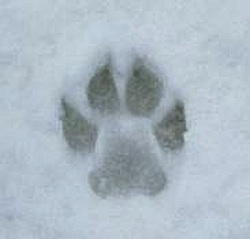
FUR:
One of the most noticeable features of wolves is the multitude of beautiful colors that their coats contain. Wolves' coats range in colors from white to black and every shade in between including brown, blond, cream, and even reddish tinge. Often the color of their coat comes in handy for camouflage with darker fur in deep forests, tam and reds in the dry southwest, or white in the Arctic. But fur isn't just used for camouflage, it is the only thing protecting an Arctic wolf from freezing to death. In fact, an Arctic wolf's guard hairs are hollow which traps heat providing warmth yet not allowing snow to melt on their fur.
One of the most noticeable features of wolves is the multitude of beautiful colors that their coats contain. Wolves' coats range in colors from white to black and every shade in between including brown, blond, cream, and even reddish tinge. Often the color of their coat comes in handy for camouflage with darker fur in deep forests, tam and reds in the dry southwest, or white in the Arctic. But fur isn't just used for camouflage, it is the only thing protecting an Arctic wolf from freezing to death. In fact, an Arctic wolf's guard hairs are hollow which traps heat providing warmth yet not allowing snow to melt on their fur.

EYES:
Wolves are usually born with deep blue eyes which lighten and then gradually fade into the adult eye color over the next six to ten weeks. A mature Wolf's eyes are often amber/brown or a golden yellow, but also commonly come in hues of brown, gray, yellow, and green. It is interesting to note that puppies are born with blue eyes, while mature Wolves do not retain blue as an eye color.
Huskies often have blue eyes, and because of this people think there must be blue eyed Wolves as well, but this isn't true. If you see a Wolf with blue eyes then he or she is likely a Wolf-hybrid and not a full-blooded Wolf.
Wolves are usually born with deep blue eyes which lighten and then gradually fade into the adult eye color over the next six to ten weeks. A mature Wolf's eyes are often amber/brown or a golden yellow, but also commonly come in hues of brown, gray, yellow, and green. It is interesting to note that puppies are born with blue eyes, while mature Wolves do not retain blue as an eye color.
Huskies often have blue eyes, and because of this people think there must be blue eyed Wolves as well, but this isn't true. If you see a Wolf with blue eyes then he or she is likely a Wolf-hybrid and not a full-blooded Wolf.

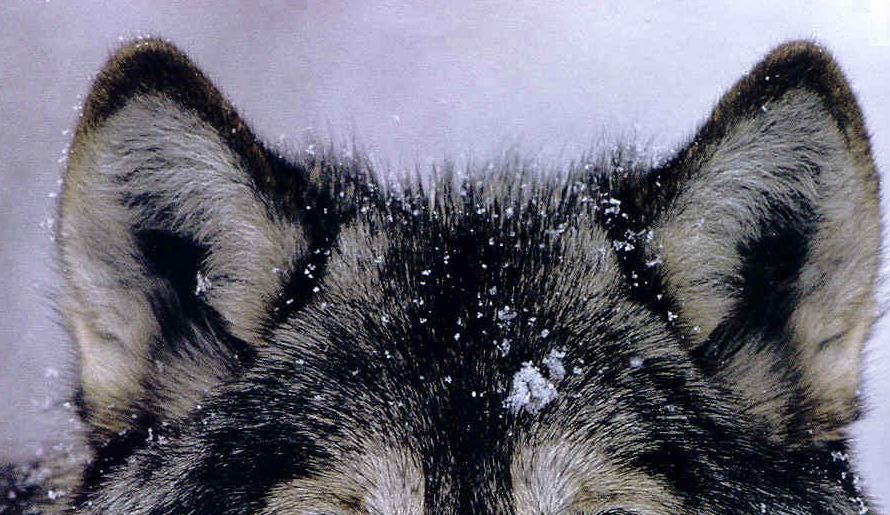
EARS:
A Wolf's ears are triangle shaped and rounded across the top; they are much broader and shorter than coyote or fox ears. Wolves tend to have shorter/darker fur on the backside of the ear, with a lighter, somewhat longer fur along the inside. Wolves are able fold their ears back against their head, move them side to side, and forward independently of each other. This range of motion assists the Wolf in detecting the direction of sound quite precisely. Wolves also use ear postures for communicating amongst themselves.
A Wolf's ears are triangle shaped and rounded across the top; they are much broader and shorter than coyote or fox ears. Wolves tend to have shorter/darker fur on the backside of the ear, with a lighter, somewhat longer fur along the inside. Wolves are able fold their ears back against their head, move them side to side, and forward independently of each other. This range of motion assists the Wolf in detecting the direction of sound quite precisely. Wolves also use ear postures for communicating amongst themselves.
Hearing is a Wolf's second most developed sense. It is thought that domestic canines can hear sixteen times better than human beings. It is supposed that a Wolf's ability to hear is even better than this. Experts believe that Wolves may be able to hear frequencies far above the limits of human beings. The upper limit of human hearing is about 20 kHz, a Wolf's upper limit has been estimated at between 25 and 80 kHz. Wolves have been known to react to imitated Wolf howls from five kilometers (three miles) away. Some experts say that a Wolf can hear ten to sixteen kilometers (six to ten miles), depending on the density of trees and other obstacles between them and the source of the sound.
NOSE:
A Wolf's nose is composed dark or black, rubber-like, tissue at the end of the muzzle and above the lip, with a pair of nostrils leading to the nasal cavity which lie above the hard palate of the mouth. The nose is the only part of the canine body that "sweats," as there are no sweat glands in the skin. The nose gets wet and cold as the Wolf exercises in order to cool the blood flowing through the muzzle and facilitate a constant body temperature.
The sense of smell is a Wolf's most developed sense and greatest asset. A domestic canine's nasal cavity has about twenty-five times the number of olfactory receptors and fourteen times the scent receptive surface area of a human being. It has been suggested by experts that a Wolf may have twelve times the ability to detect odors compared to a domestic canine and a hundred times that ability of a human being.
A Wolf's nose is composed dark or black, rubber-like, tissue at the end of the muzzle and above the lip, with a pair of nostrils leading to the nasal cavity which lie above the hard palate of the mouth. The nose is the only part of the canine body that "sweats," as there are no sweat glands in the skin. The nose gets wet and cold as the Wolf exercises in order to cool the blood flowing through the muzzle and facilitate a constant body temperature.
The sense of smell is a Wolf's most developed sense and greatest asset. A domestic canine's nasal cavity has about twenty-five times the number of olfactory receptors and fourteen times the scent receptive surface area of a human being. It has been suggested by experts that a Wolf may have twelve times the ability to detect odors compared to a domestic canine and a hundred times that ability of a human being.
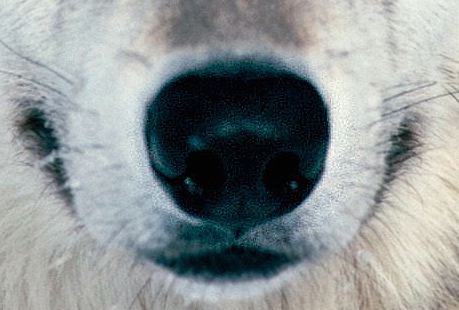
The sense of smell plays a very important role in wolf's life and society. Not only is it the means by which Wolves detect and locate pray, but it is instrumental in a variety of other tasks. A Wolf's body has scent glands that tell a Wolf's health, mood, and identity to other Wolves. Upon meeting, Wolves will smell each others muzzle, anus, and tail to make sure they know who the other Wolf is, and also learn details about health, mood, where the Wolf has been, and what she/he has been eating. Wolves use urination (marking), to mark their territories so other Wolves may know they are crossing into another pack's land by smelling the marks.

PACKS:
Wolves are known for their social behavior and family-like social structure. Almost all wolves in the wild live in a structure known as a "Pack". A pack is a group of wolves that live together for several years, if not their entire life. Pack size can vary from a pair to more than 40 individuals but, they usually average 4 - 7. Larger packs are abnormal and are the result of environmental or man-made pressures on a wolf population.
Wolves are known for their social behavior and family-like social structure. Almost all wolves in the wild live in a structure known as a "Pack". A pack is a group of wolves that live together for several years, if not their entire life. Pack size can vary from a pair to more than 40 individuals but, they usually average 4 - 7. Larger packs are abnormal and are the result of environmental or man-made pressures on a wolf population.

Historically, a wolf pack has been explained to consist of certain "ranks" which wolves can hold in the pack. These ranks consist of "Alphas", "Betas", "Subordinates", and "Omegas". Although, not every rank will necessarily be occupied in a pack, there is always at least one, if not two, alphas.
The Alpha(s) are the leaders of the pack, commonly also the parents of the other pack members, and are normally the only ones with the right to breed.
Usually when a pack is made up of non-blood related family members, it is due to human involvement.
The beta(s) are wolves who hold the second highest rank in the pack. Normally they are in charge when the Alpha(s) are not present. Wolves that consist of the majority of the pack and don't hold a special rank are called subordinates. These wolves are the "everyday" members of the pack and usually the grown up pups of the alpha(s). The lowest rank in the pack belongs to the omega(s). These wolves are normally the dedicated pup-sitters of the pack, while omegas seem to suffer some mistreatment from the other wolves, they are still very much cherished by the pack, omegas are also the last to eat at every meal - if, there is anything left over at all. However as bad as the life may seem for an omega, they are an essential part of the wolf population as a whole.
The Alpha(s) are the leaders of the pack, commonly also the parents of the other pack members, and are normally the only ones with the right to breed.
Usually when a pack is made up of non-blood related family members, it is due to human involvement.
The beta(s) are wolves who hold the second highest rank in the pack. Normally they are in charge when the Alpha(s) are not present. Wolves that consist of the majority of the pack and don't hold a special rank are called subordinates. These wolves are the "everyday" members of the pack and usually the grown up pups of the alpha(s). The lowest rank in the pack belongs to the omega(s). These wolves are normally the dedicated pup-sitters of the pack, while omegas seem to suffer some mistreatment from the other wolves, they are still very much cherished by the pack, omegas are also the last to eat at every meal - if, there is anything left over at all. However as bad as the life may seem for an omega, they are an essential part of the wolf population as a whole.
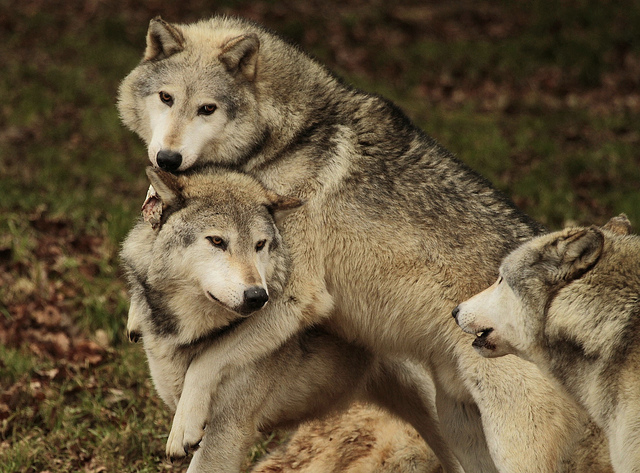
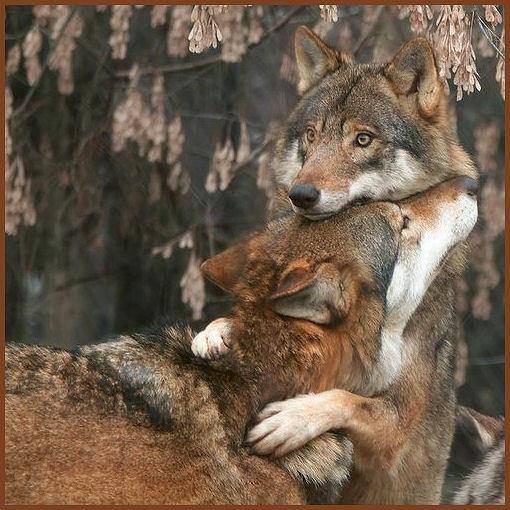
It is not unusual for an omega or for another member to leave the pack and search for a mate, to create an entirely new pack and bloodline with. This keeps the bloodline of wolves much more diverse.
While the prior has been the acceptable pack structure for years, a truly wild wolf pack without human influence will be composed of a mother, father, and their pups for the successive recent generations. Instead of wolves challenging the alphas for their status, pups will instead disperse from their parents and siblings once they reach sexual maturity to find a mate and raise their own family.
While the prior has been the acceptable pack structure for years, a truly wild wolf pack without human influence will be composed of a mother, father, and their pups for the successive recent generations. Instead of wolves challenging the alphas for their status, pups will instead disperse from their parents and siblings once they reach sexual maturity to find a mate and raise their own family.
PACK RANKS:
ALPHAS
- Leaders of the pack
- First to eat
- Tail and posture raised high
- Only ones to breed
BETAS
- Second in command
- Submissive to Alphas
SUBORDINATES
- Majority of the pack
- Submissive to Alphas & Betas
OMEGAS
- Lowest ranking wolf/wolves
- Submissive to everyone
- Eats last if at all
- Usually will leave the pack if not replaced
in rank by pups of the next generation.
ALPHAS
- Leaders of the pack
- First to eat
- Tail and posture raised high
- Only ones to breed
BETAS
- Second in command
- Submissive to Alphas
SUBORDINATES
- Majority of the pack
- Submissive to Alphas & Betas
OMEGAS
- Lowest ranking wolf/wolves
- Submissive to everyone
- Eats last if at all
- Usually will leave the pack if not replaced
in rank by pups of the next generation.
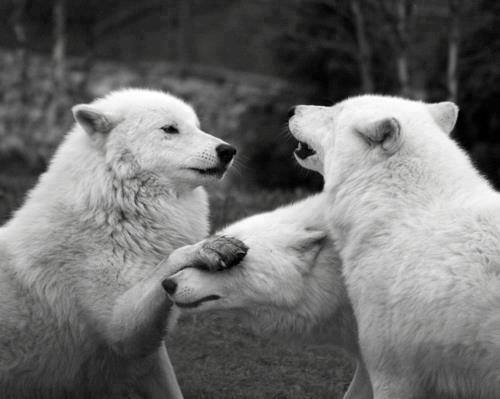
COMMUNICATION:

Due to the vast range of territory that the wolf occupies around the globe, the prey type of individual species varies greatly based on the specific region in which the species live. For example, Arctic wolves have been known to hunt musk oxen, caribou, arctic hare, and other smaller animals such as lemmings.
In the Plains and flat country, wolves prey on elk, deer and rabbits. Mountains provide wolves with larger prey such as elk, moose, and deer. In general wolves have been known to prey on animals ranging in size from mice to Musk Oxen and everything in between however wolves mainly prey on what are called "Ungulates", more broadly described as hoofed mammals (though not all are) such as the more common example of deer and elk.
In the Plains and flat country, wolves prey on elk, deer and rabbits. Mountains provide wolves with larger prey such as elk, moose, and deer. In general wolves have been known to prey on animals ranging in size from mice to Musk Oxen and everything in between however wolves mainly prey on what are called "Ungulates", more broadly described as hoofed mammals (though not all are) such as the more common example of deer and elk.
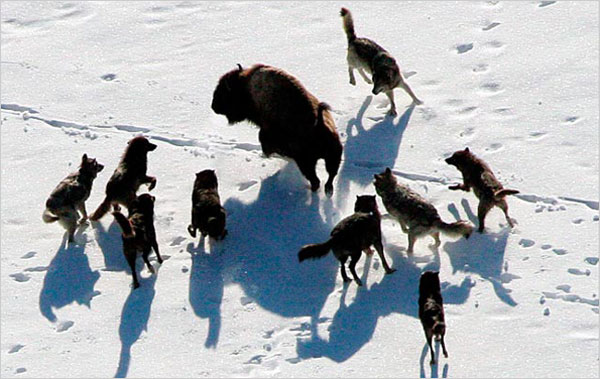
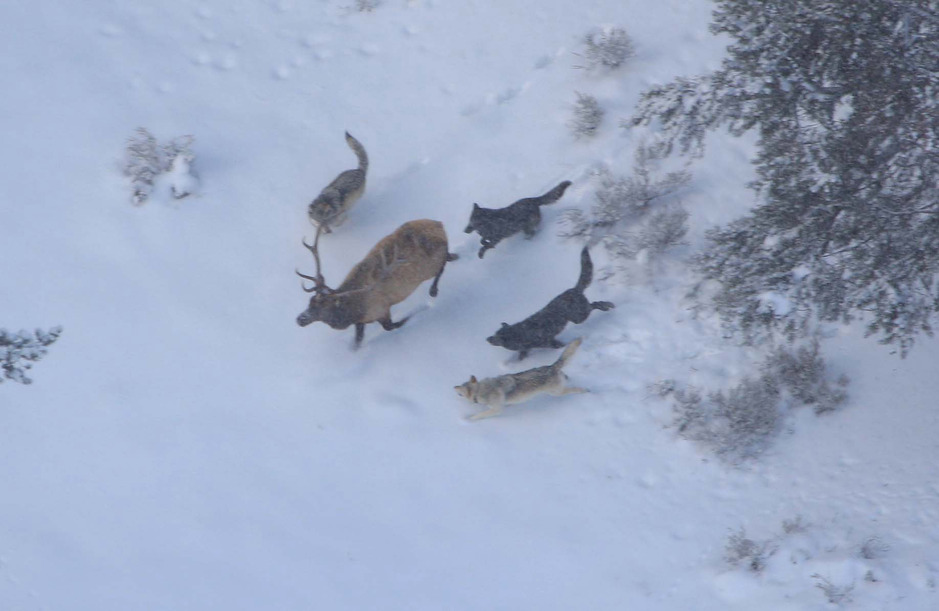
Unlike many familiar predators such as many species of cats and bears, wolves hunt together as a pack. This requires a level of coordination rarely seen in nature. During a hunt, generally on a herd of animals, several wolves will communicate with each other, while attempting to test and single out a chosen animal. They will then simultaneously converge and attack their target and bring it down. In most cases, wolves will try and kill the easiest targets - the sick, wounded, old or very young. Not only is this easier for the wolf to take down, but it helps the prey population as a whole.
Animals that are sick and wounded diminish the health of the herd by either spreading disease or slowing it down. Predators, such as wolves, remove those animals without the ability to contract the disease themselves, and assist in keeping the herd fit and strong.
Animals that are sick and wounded diminish the health of the herd by either spreading disease or slowing it down. Predators, such as wolves, remove those animals without the ability to contract the disease themselves, and assist in keeping the herd fit and strong.
One great misnomer about wolves and hunting is that wolves will at times kill for sport - or, at very least, much more than they need for food. This in fact, is not true.
Wolves may, at times, kill more than the pack will eat in one day. However, the pack will often return to the same kill several times in order to finish eating the carcass. This is both beneficial to the wolf, which can kill a large prey once and eat many times, as well as it is beneficial to the ecosystem and other scavengers who may also gain a free meal from it.
Wolves may, at times, kill more than the pack will eat in one day. However, the pack will often return to the same kill several times in order to finish eating the carcass. This is both beneficial to the wolf, which can kill a large prey once and eat many times, as well as it is beneficial to the ecosystem and other scavengers who may also gain a free meal from it.

Wolves have a complex communication system which encompasses a variety of physical, olfactory, and vocal gestures. None of these can be singled out as the most important, but all work in concert to show the emotions and intent of the wolf and the current or future actions.
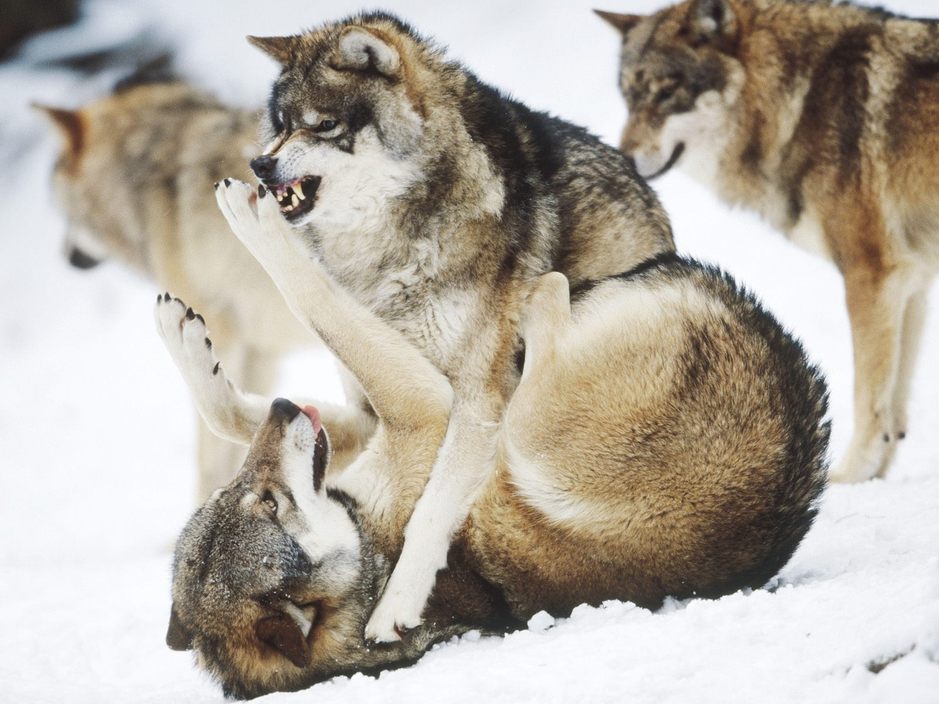
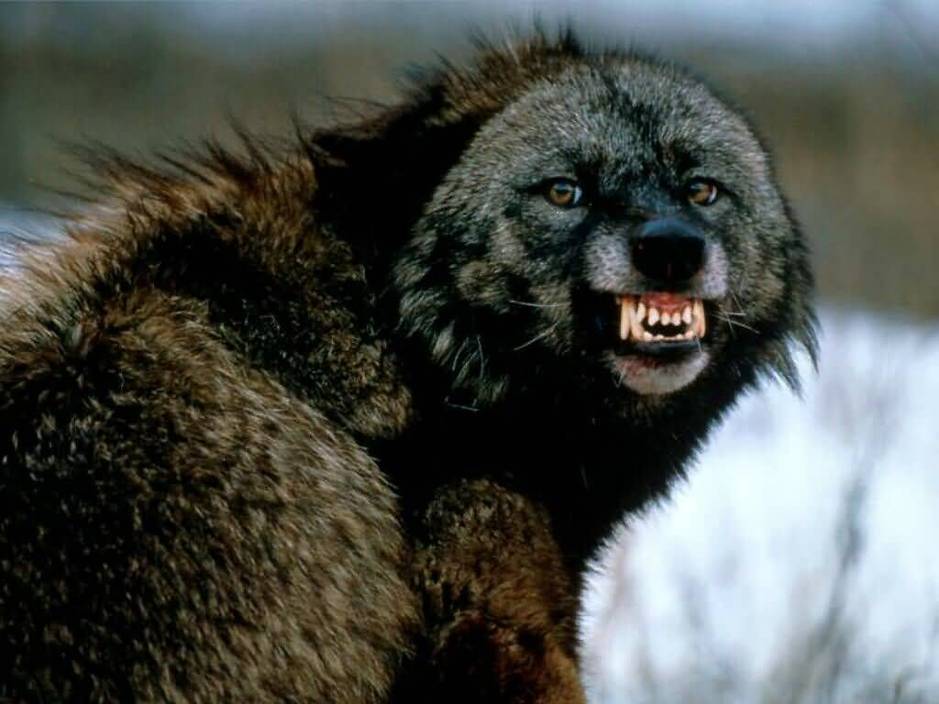
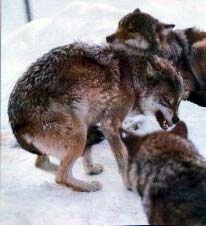
PHYSICAL COMMUNICATION:
The physical communication of a wolf can generally be categorized in three distinct, but related, sections: facial communication, tail communication, and body communication.
Just like all forms of communication work in concert, these three forms of physical communication work together to describe the wolf's emotion and intent.
The physical communication of a wolf can generally be categorized in three distinct, but related, sections: facial communication, tail communication, and body communication.
Just like all forms of communication work in concert, these three forms of physical communication work together to describe the wolf's emotion and intent.
FACIAL COMMUNICATION:
Facial communication is generally the most commonly recognized communication by people, but most do not understand the finite details. In general, facial communication can describe an increase of fear and an increase in aggression. A relaxed wolf whom is not expressing dominance or submission, will generally have its ears upright. As confidence (dominance) increases, the ears will tilt forward, as fear (submission) increases, the ears will tilt backward. Facial communication is also conveyed through the wolf's muzzle. As aggression increases, the skin on the muzzle will pull back to expose the wolf's teeth and continue by opening it's mouth at the peak of aggression and likeliness to attack.
Facial communication is generally the most commonly recognized communication by people, but most do not understand the finite details. In general, facial communication can describe an increase of fear and an increase in aggression. A relaxed wolf whom is not expressing dominance or submission, will generally have its ears upright. As confidence (dominance) increases, the ears will tilt forward, as fear (submission) increases, the ears will tilt backward. Facial communication is also conveyed through the wolf's muzzle. As aggression increases, the skin on the muzzle will pull back to expose the wolf's teeth and continue by opening it's mouth at the peak of aggression and likeliness to attack.
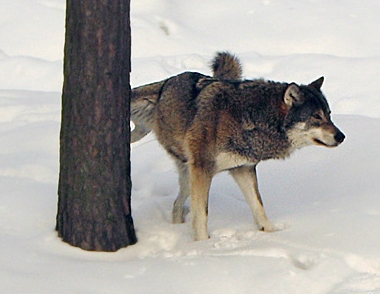
OLFACTORY COMMUNICATION:
Wolves are covered with a multitude of scent glands which cover areas of the skin. Wolves use these scent glands to communicate gender, emotions, and some research even suggests that they convey the wolf's unique identity. A wolf will use the scent glands on its paws to mark a site by scratching the ground with it's forelegs and back legs - a common post excretion action. A common canine action of greeting each other by lining side to side, head to tail, is common for wolves due to the presence of anal scent glands which likely hold information about the individual. The most noticeable gland on a wolf is the tail scent gland that is located about 1/3 of the way down from the top of the tail and appears black in color on all wolves. The purpose of this gland is still not yet completely understood.
Wolves are covered with a multitude of scent glands which cover areas of the skin. Wolves use these scent glands to communicate gender, emotions, and some research even suggests that they convey the wolf's unique identity. A wolf will use the scent glands on its paws to mark a site by scratching the ground with it's forelegs and back legs - a common post excretion action. A common canine action of greeting each other by lining side to side, head to tail, is common for wolves due to the presence of anal scent glands which likely hold information about the individual. The most noticeable gland on a wolf is the tail scent gland that is located about 1/3 of the way down from the top of the tail and appears black in color on all wolves. The purpose of this gland is still not yet completely understood.
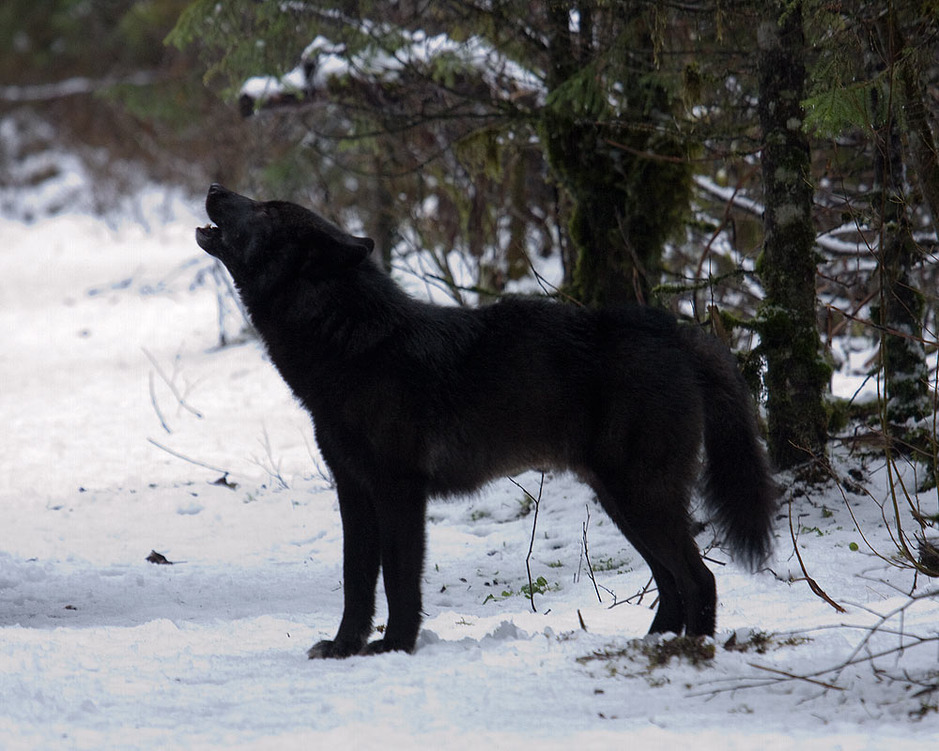
VOCAL COMMUNICATION:
Researchers have confirmed that Wolves produce a multitude of different sounds to convey thoughts and emotions. Gruffing, squeaking, barking, chuffing, whining, snarling, whimpering, and murring are just a small selection of sounds that a wolf can produce during their lifetime. In general each sound has a variety of purposes and can only be interpreted in the context of when it was produced - much like human languages.
The most commonly known sound is that of a wolf's howl. A common misconception of the occurrence of this sound is that wolves howl at the moon. There is no evidence to suggest that wolves are somehow enticed to howl at the moon for the sake of simply howling at the moon. Instead, howling appears to be most commonly used in the form of long distance communication. One theory of why wolves appear to "howl at the moon" has to do with another action - hunting. In many parts of the wolf's global territory, summer temperatures can become less than comfortable with a full coat of fur.
Thus, hunting in the cool of the night.
Moonlit nights yield a greater ability for wolves to see. After a hunt is completed, it is not uncommon for a pack to howl for a variety of reasons. So wolves may indeed howl more often on moonlit nights, but research suggests that it has nothing to do with a wolf's desire to howl at the moon itself.
Researchers have confirmed that Wolves produce a multitude of different sounds to convey thoughts and emotions. Gruffing, squeaking, barking, chuffing, whining, snarling, whimpering, and murring are just a small selection of sounds that a wolf can produce during their lifetime. In general each sound has a variety of purposes and can only be interpreted in the context of when it was produced - much like human languages.
The most commonly known sound is that of a wolf's howl. A common misconception of the occurrence of this sound is that wolves howl at the moon. There is no evidence to suggest that wolves are somehow enticed to howl at the moon for the sake of simply howling at the moon. Instead, howling appears to be most commonly used in the form of long distance communication. One theory of why wolves appear to "howl at the moon" has to do with another action - hunting. In many parts of the wolf's global territory, summer temperatures can become less than comfortable with a full coat of fur.
Thus, hunting in the cool of the night.
Moonlit nights yield a greater ability for wolves to see. After a hunt is completed, it is not uncommon for a pack to howl for a variety of reasons. So wolves may indeed howl more often on moonlit nights, but research suggests that it has nothing to do with a wolf's desire to howl at the moon itself.

How fast do wolves run?
A wolf is generally a stamina runner and, while it can achieve 30 - 40 mph for a brief time, it generally travels much slower. Generally a wolf can travel at a loping speed of approximately 5 - 10 mph for several hours without stopping.
A wolf is generally a stamina runner and, while it can achieve 30 - 40 mph for a brief time, it generally travels much slower. Generally a wolf can travel at a loping speed of approximately 5 - 10 mph for several hours without stopping.
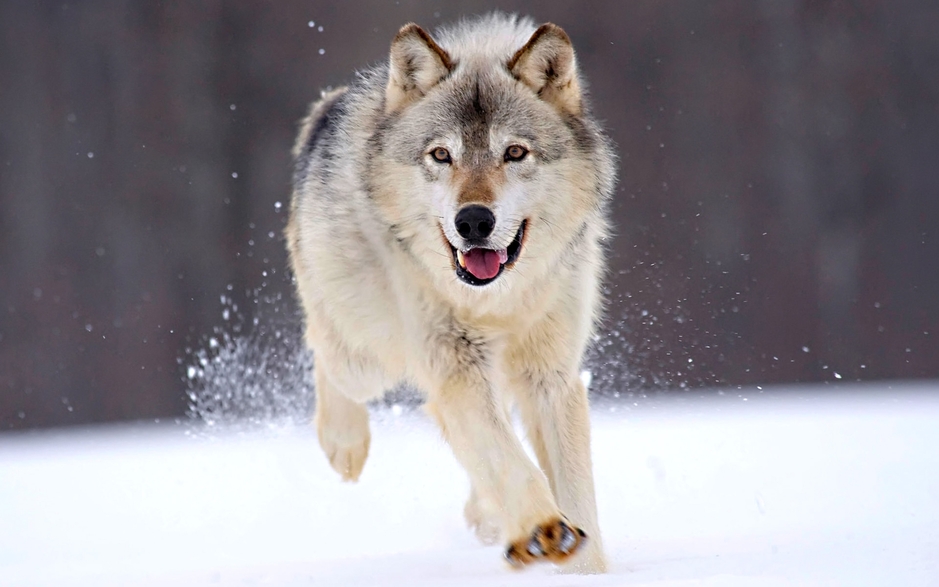
Are wolves a threat to humans, and do they attack/kill humans like in fairy tales?
This is quite possibly the largest myth about wolves. There has never been a proven/documented incident where a healthy, wild, unprovoked wolf has attacked or injured a human in North America. While this is often criticized as a "wolf lovers" statement, there are facts behind it.
Wolves do not identify humans as prey because of a human's size, and their own predatory status. Humans are also not held to their territorial rules because human are not canines. In fact, the only cases where a healthy and wild wolf has ever hurt a human has been under conditions where the human has provoked the attack by harming the wolf or threatening their pup's safety!
Wolves are generally shy, timid animals who would prefer to live in peace, and will run at the sight of a human.
Wolves will only attack if their pack/pups (family/children) are being threatened/harmed or if provoked into having to defend themselves.
This is quite possibly the largest myth about wolves. There has never been a proven/documented incident where a healthy, wild, unprovoked wolf has attacked or injured a human in North America. While this is often criticized as a "wolf lovers" statement, there are facts behind it.
Wolves do not identify humans as prey because of a human's size, and their own predatory status. Humans are also not held to their territorial rules because human are not canines. In fact, the only cases where a healthy and wild wolf has ever hurt a human has been under conditions where the human has provoked the attack by harming the wolf or threatening their pup's safety!
Wolves are generally shy, timid animals who would prefer to live in peace, and will run at the sight of a human.
Wolves will only attack if their pack/pups (family/children) are being threatened/harmed or if provoked into having to defend themselves.
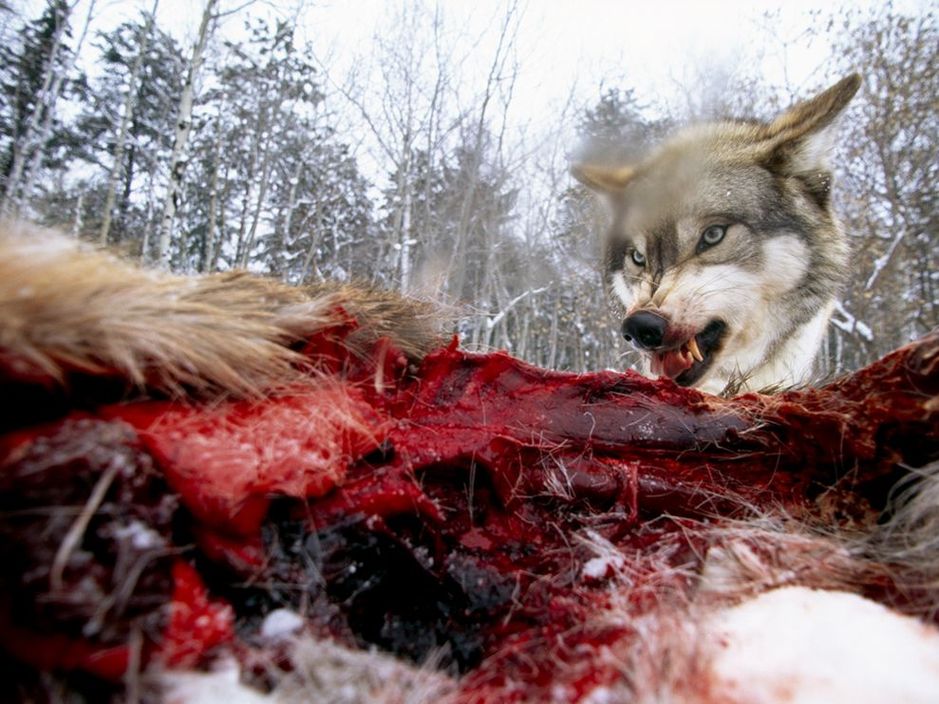

MORE TO COME SOON!
It was said that dogs only see in black & white, does this mean wolves only see in black and white?
This is a common mistake to make. While wolves do not see in the same color humans do, wolves see in an arrangement of pastel colors. Unlike humans, wolves have an extraordinary sense of smell which easily compensates for their lack of color saturation.
This is a common mistake to make. While wolves do not see in the same color humans do, wolves see in an arrangement of pastel colors. Unlike humans, wolves have an extraordinary sense of smell which easily compensates for their lack of color saturation.
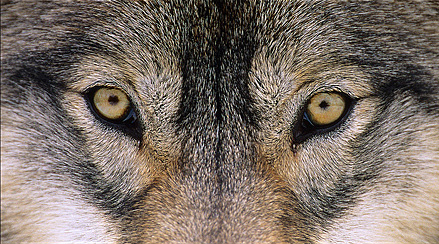
My dog has amber or brown eyes, does it have wolf in it?
Eye color can only prove that a wolf is not a full blood wolf, but it cannot tell you if a dog has "Wolf blood".
All full-blooded wolves have a amber, brown, or a variation of the color eyes mentioned above. But a dog that has amber or brown eyes does not necessarily have any "wolf blood" in them.
Eye color can only prove that a wolf is not a full blood wolf, but it cannot tell you if a dog has "Wolf blood".
All full-blooded wolves have a amber, brown, or a variation of the color eyes mentioned above. But a dog that has amber or brown eyes does not necessarily have any "wolf blood" in them.
How can you tell the difference between a wolf and a coyote?
For the untrained eye, it can be very difficult, but generally you can use range as a good indicator.
If you see a "wolf" in Kansas, it's likely actually a coyote. But if you are in a state where wolves are known to live in, it's generally good to look at two features: Ears and paws. Coyotes generally have small paws while wolves have very large paws. Wolves generally have shorter ears and longer muzzles in comparison to coyotes that have larger ears and shorter muzzles. Coyotes are generally smaller then most wolf species. These are some generally concepts and there are many exceptions to the rule.
For the untrained eye, it can be very difficult, but generally you can use range as a good indicator.
If you see a "wolf" in Kansas, it's likely actually a coyote. But if you are in a state where wolves are known to live in, it's generally good to look at two features: Ears and paws. Coyotes generally have small paws while wolves have very large paws. Wolves generally have shorter ears and longer muzzles in comparison to coyotes that have larger ears and shorter muzzles. Coyotes are generally smaller then most wolf species. These are some generally concepts and there are many exceptions to the rule.

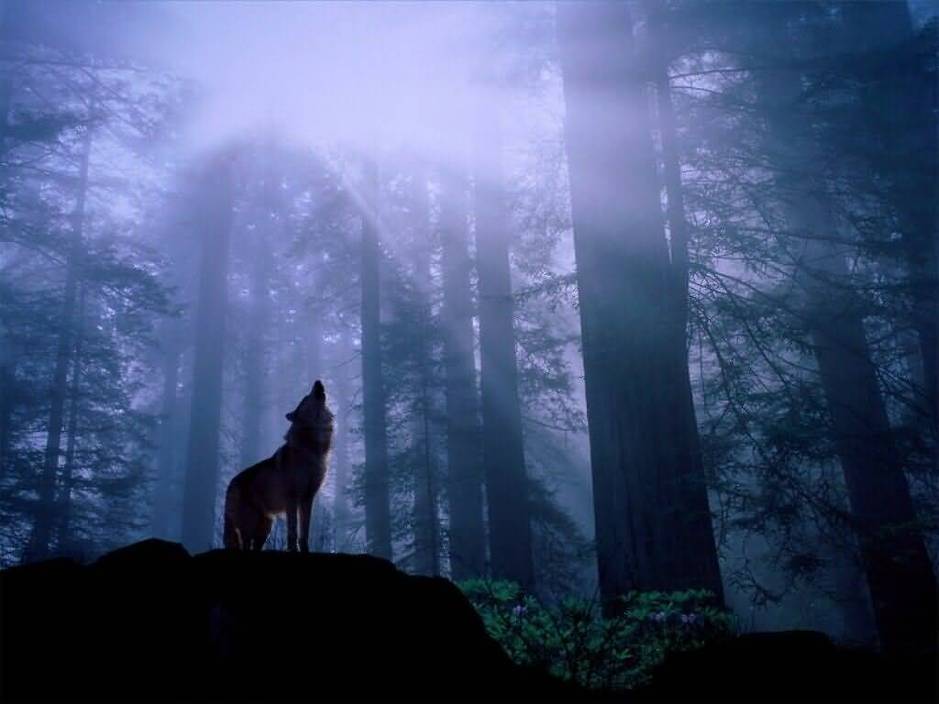
Where can I see a wolf in the wild?
Seeing a wolf in the wild is a very rare but extremely lucky and wondrous sight to see!
Unfortunately, there are very few places where you can see wolves in the wild on a regular basis.
'Yellowstone National Park' is one place where wolf watchers visit and have the best chance of seeing them in their natural habitat. But, even in Yellowstone it is a rare sight and anyone who has seen a wolf in the wild should count it as a extremely lucky blessing, once in a life time experience.
Seeing a wolf in the wild is a very rare but extremely lucky and wondrous sight to see!
Unfortunately, there are very few places where you can see wolves in the wild on a regular basis.
'Yellowstone National Park' is one place where wolf watchers visit and have the best chance of seeing them in their natural habitat. But, even in Yellowstone it is a rare sight and anyone who has seen a wolf in the wild should count it as a extremely lucky blessing, once in a life time experience.
Where can I see a real wolf in captivity?
There are actually many Wolf Sanctuaries & Zoos available where you can go and see real wolves in captivity.
Check out the "Sanctuaries" section of the website to find out about some good sanctuaries, or contact your local zoo.
There are actually many Wolf Sanctuaries & Zoos available where you can go and see real wolves in captivity.
Check out the "Sanctuaries" section of the website to find out about some good sanctuaries, or contact your local zoo.
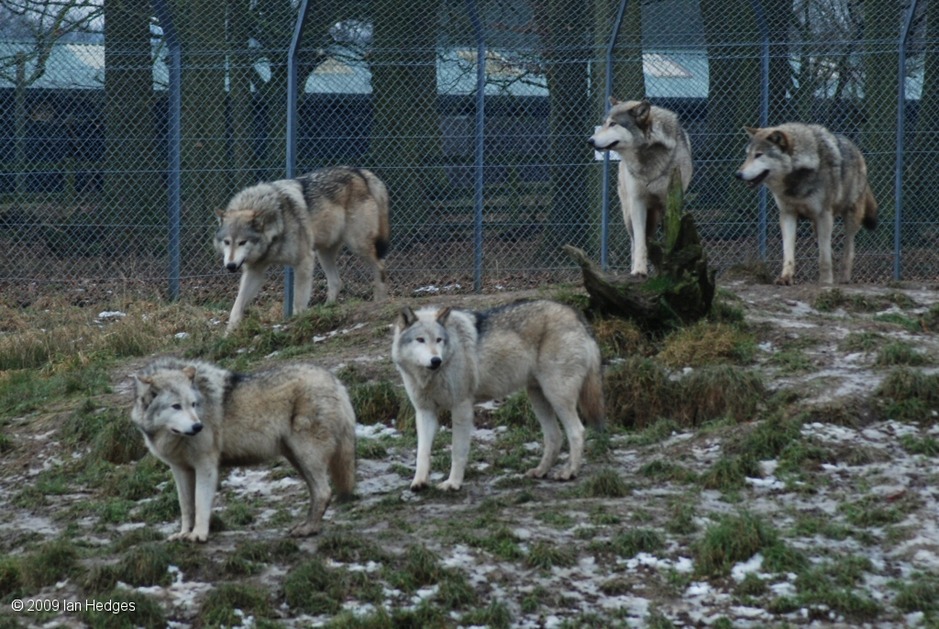
I want to own a wolf, where can I get one?
In most states, owning a wolf as a private individual is illegal and I as well as many others believe that it should be illegal in every state. Wolves are beautiful, majestic, wondrous, inspiring and intelligent - but they are also wild. They belong in the wild not in someone's back yard.
In most states, owning a wolf as a private individual is illegal and I as well as many others believe that it should be illegal in every state. Wolves are beautiful, majestic, wondrous, inspiring and intelligent - but they are also wild. They belong in the wild not in someone's back yard.
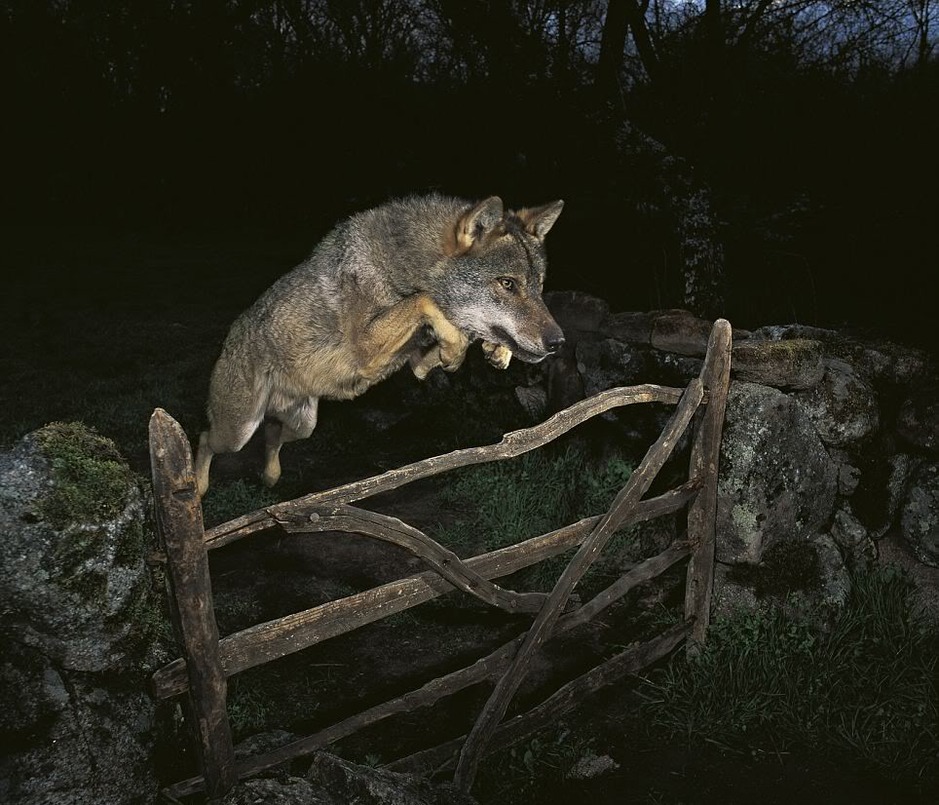
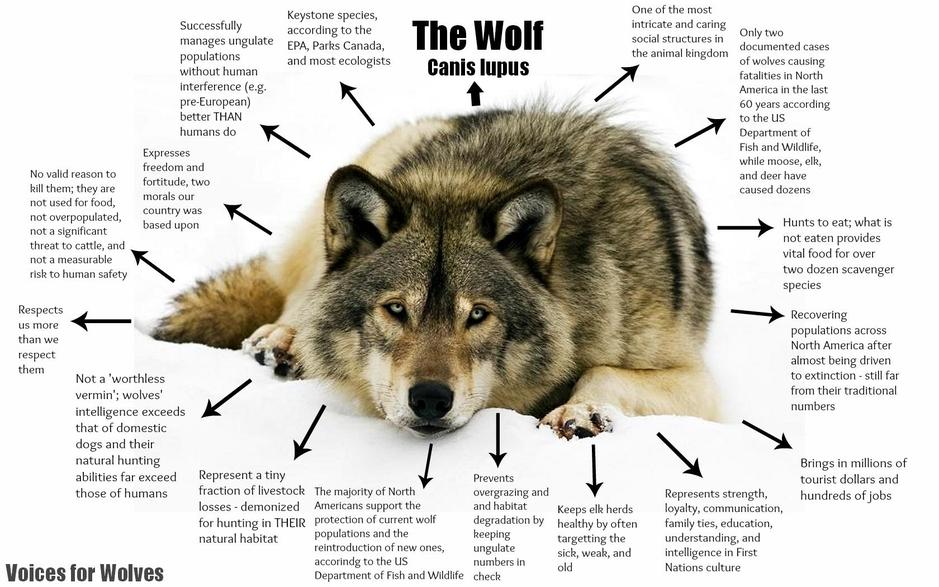
10 Reasons We Need Wolves
Reason 1: Without wolves and other large predators, ecosystems can go haywire. A 2001 study found that when wolves went extinct in Yellowstone, for example, the moose population ballooned to five times its normal size and demolished woody vegetation where birds nested. As a result, several bird species were eliminated in the park.
Reason 2: Scavengers thrive when wolves are around. The species that help themselves to wolves' leftovers include ravens, magpies, wolverines, bald eagles, golden eagles, three weasel species, mink, lynx, cougar, grizzly bear, chickadees, masked shrew, great gray owl, and more than 445 species of beetle.
Reason 3: Wolf kills are also good for the soil. A 2009 study in Michigan's Isle Royale National Park found that wolf-killed elk carcasses dramatically enhanced levels of nitrogen and other nutrients.
Reason 4: Wolf kills feed more animals than hunting by humans, since wolves scatter their carrion over the landscape. Wolf kills benefit three times more species than human hunting kills. The carcass above was a bull elk killed by a pack of eight wolves in Agate Creek, Yellowstone. The skeleton was picked clean by wolves and scavengers in less than five days.
Reason 5: When wolves disappeared from Yellowstone, coyotes preyed on pronghorn almost to the point of no return. But since wolves have returned, the pronghorn have come back. In fact, pronghorns tend to give birth near wolf dens, since coyotes steer clear of those areas.
Reason 6: Deer and elk congregate in smaller groups when wolves are around. This helps reduce the transmission of illnesses like Chronic Wasting Disease.
Reason 7: Chronic Wasting Disease is a major threat to elk and deer in the West. Wolves can help by reducing sick animals' lifespans, in turn limiting the amount of time they can spread infections.
Reason 8: Yellowstone elk are less likely to overgraze near rivers and streams—damaging fragile ecosystems—when wolves are in the neighborhood.
Reason 9: Wolves help protect against climate change. A 2005 UC Berkeley study in Yellowstone concluded that milder winters, a product of climate change, have led to fewer elk deaths. This left scavengers like coyotes and ravens scrambling for food, but the problem was far less pervasive in areas where wolves were around to hunt elk.
Reason 10: Wolf tourism is an economic boon. Restoration of wolves in Yellowstone has cost about $30 million, but it's brought in $35.5 million annual net benefit to the area surrounding the park.
Reason 1: Without wolves and other large predators, ecosystems can go haywire. A 2001 study found that when wolves went extinct in Yellowstone, for example, the moose population ballooned to five times its normal size and demolished woody vegetation where birds nested. As a result, several bird species were eliminated in the park.
Reason 2: Scavengers thrive when wolves are around. The species that help themselves to wolves' leftovers include ravens, magpies, wolverines, bald eagles, golden eagles, three weasel species, mink, lynx, cougar, grizzly bear, chickadees, masked shrew, great gray owl, and more than 445 species of beetle.
Reason 3: Wolf kills are also good for the soil. A 2009 study in Michigan's Isle Royale National Park found that wolf-killed elk carcasses dramatically enhanced levels of nitrogen and other nutrients.
Reason 4: Wolf kills feed more animals than hunting by humans, since wolves scatter their carrion over the landscape. Wolf kills benefit three times more species than human hunting kills. The carcass above was a bull elk killed by a pack of eight wolves in Agate Creek, Yellowstone. The skeleton was picked clean by wolves and scavengers in less than five days.
Reason 5: When wolves disappeared from Yellowstone, coyotes preyed on pronghorn almost to the point of no return. But since wolves have returned, the pronghorn have come back. In fact, pronghorns tend to give birth near wolf dens, since coyotes steer clear of those areas.
Reason 6: Deer and elk congregate in smaller groups when wolves are around. This helps reduce the transmission of illnesses like Chronic Wasting Disease.
Reason 7: Chronic Wasting Disease is a major threat to elk and deer in the West. Wolves can help by reducing sick animals' lifespans, in turn limiting the amount of time they can spread infections.
Reason 8: Yellowstone elk are less likely to overgraze near rivers and streams—damaging fragile ecosystems—when wolves are in the neighborhood.
Reason 9: Wolves help protect against climate change. A 2005 UC Berkeley study in Yellowstone concluded that milder winters, a product of climate change, have led to fewer elk deaths. This left scavengers like coyotes and ravens scrambling for food, but the problem was far less pervasive in areas where wolves were around to hunt elk.
Reason 10: Wolf tourism is an economic boon. Restoration of wolves in Yellowstone has cost about $30 million, but it's brought in $35.5 million annual net benefit to the area surrounding the park.
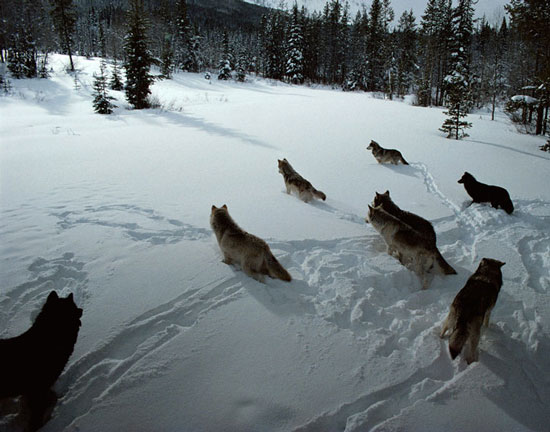
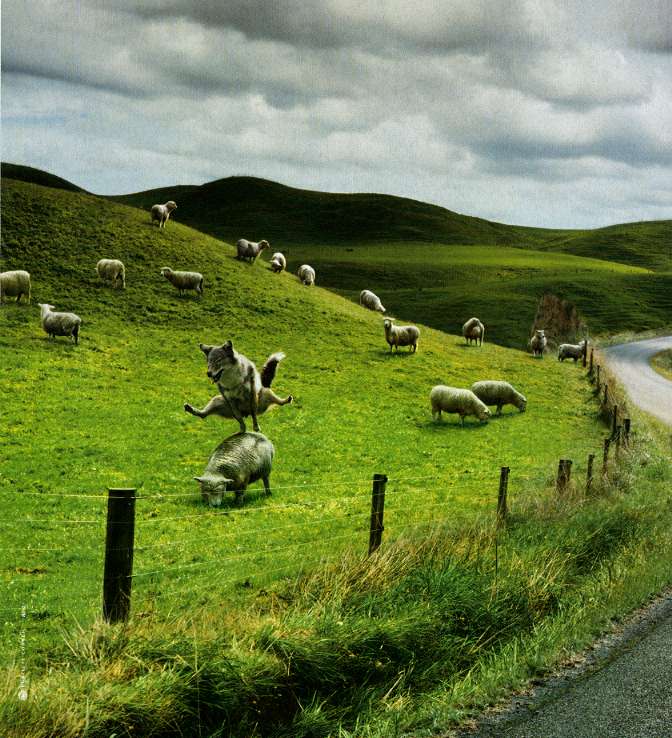
Are wolves really a threat to livestock?
No.
Scientific research has shown that wolves are only responsible for ".008%" of livestock deaths. Which barely makes 1% of livestock loss.
Also all livestock owners who experience verified depredation losses to wolves receive compensation/reimbursement for their losses.
It is also extremely important to point out 'why' wolves will attack livestock at all;
Wolves while rarely doing so, tend to prey on livestock only due to one of two reasons.
1.) When the Alpha wolves or pack members are killed by hunters, the structure is then broken. Due to this broken structure of the pack, the wolves are no longer able to successfully hunt for their prey, and because of this, the wolves then will seek out easier prey to hunt, which then leads to the rare targeting of livestock.
2.) A shortage in their own normal food source.
This shortage happens to come about due to "Humans" and their "sport hunting".
No.
Scientific research has shown that wolves are only responsible for ".008%" of livestock deaths. Which barely makes 1% of livestock loss.
Also all livestock owners who experience verified depredation losses to wolves receive compensation/reimbursement for their losses.
It is also extremely important to point out 'why' wolves will attack livestock at all;
Wolves while rarely doing so, tend to prey on livestock only due to one of two reasons.
1.) When the Alpha wolves or pack members are killed by hunters, the structure is then broken. Due to this broken structure of the pack, the wolves are no longer able to successfully hunt for their prey, and because of this, the wolves then will seek out easier prey to hunt, which then leads to the rare targeting of livestock.
2.) A shortage in their own normal food source.
This shortage happens to come about due to "Humans" and their "sport hunting".